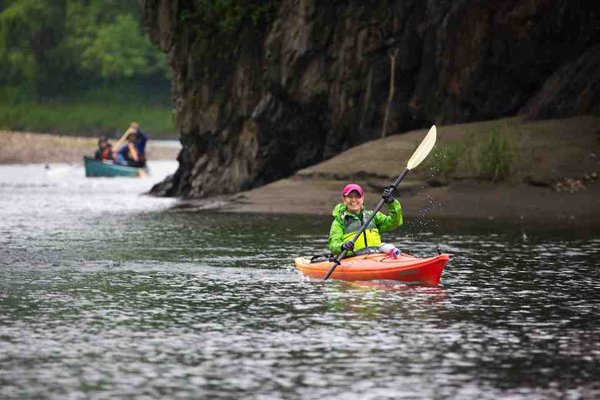
Even during the shoulder seasons!
Autumn is Awesome! You know how the weather goes at this time of year. Yesterday was crappy, but the forecast for today is sunny and warm? There are more good paddling days ahead, so long as you are dressed for what autumn weather brings. Here are the 5 key things you need to know to be ready to paddle! In almost any weather!
1. Dry suit: Paddling in the shoulder seasons can be as comfortable as summer, so long as you have a decent dry suit. It separates the outside weather from the comfy environment you create next to your body.
A proper paddling dry suit will have built-in socks so you can keep your feet warm with light or heavy Merino socks, as the conditions warrant. And the built-in socks will keep your feet warm and dry when wading or getting in and out of your boat. Warm feet = happy paddler!
A good suit will also have a relief zip (i.e. a “fly”) so you can relieve yourself as needed. Holding onto urine chills you off and is simply not comfortable. “nuff said?
If you are paddling on the lake or the ocean you will really benefit from a built-in hood. I use mine to fine-tune my internal temperature by pulling it on or off, as conditions demand. It also keeps the rain off my head! For paddling on rivers, hoods are not advised. Fortunately, many dry suits with hoods make those hoods removeable.
During October, we have drysuits on sale! Any of us will be happy to help you get the right suit for you!
2. Insulation: Dry suits keep you dry: it’s what you wear under them that keeps you warm. Just like when you dress to do any activity outside, you need to adjust the insulation to suit the conditions. In warm weather with cold water, I wear light layers under my suit. At this time of year, I’ll wear something thicker. In a canoe or kayak, my lower body layers are thicker than my upper body layers, because the torso is doing most of the work – for SUP the layers are the same thickness. When you are ready to brave it, even paddling in winter is comfortable!
Right now, we have IceBreaker Merino clothing up to 40% OFF!
3. Hands: It is important to keep hands warm! Fortunately, neoprene gloves and mitts work great to do exactly that. This time of year, the thick neoprene is called for. Personally, I prefer the neoprene mitts that are pre-curved. They make it easy to hold your paddle and each finger keeps its neighbours warm. When it’s extra cold, or if you expect to be needing occasional dexterity, you can use a pair of liner gloves under the mitts!
4. Head: Your mother was right when she told you to “wear a hat” when it’s cooler. The head is a primary source of heat loss. But that’s easy. Use the same hat you would use if you were walking beside the water that day – just make sure it is wool or synthetic so it stays warm even if you get it wet! Plus, you have your dry suit hood for the fine adjustments.
If you are paddling on the river, use a helmet liner and helmet. The helmet liner should have ear coverage for the colder days.
5. Feet: Your dry suit and your IceBreaker socks are doing most of the job of keeping your toes warm, but beware of wearing the same snug-fitting booties that you wear all summer. With the extra layers in those booties the circulation to your toes becomes restricted and that means cold feet. No one operates well with cold feet, so be sure to use paddling footwear that leaves room for your dry suit and socks!
At Undercurrents, we are here to get you onto the water! Please drop by or call with any questions about dressing for the weather. Our experts have all the answers!
As the boss is fond of saying, “There is no bad weather; there is only bad gear and bad attitudes!” Which he usually follows that with, “If man can walk in space, we can paddle after bikini season!”


